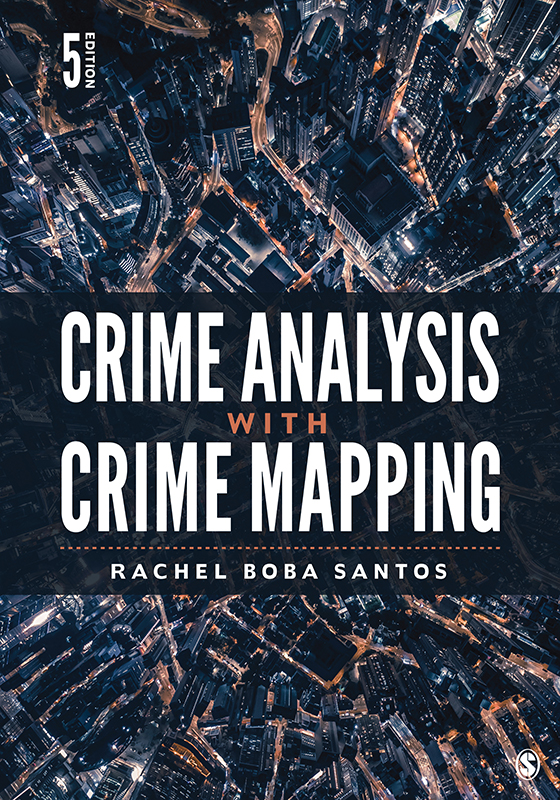Crime Analysis with Crime Mapping
Fifth Edition
Rachel Boba Santos - Radford University, USA
Rachel Boba Santos - Radford University, USA
504 pages
| February, 2022
| SAGE Publications, Inc
Instant Access!
eBook
ISBN: 9781071831427
Paperback
ISBN: 9781071831403
$135.00
Instant Access!
eBook
ISBN: 9781071831427
Crime Analysis With Crime Mapping, Fifth Edition provides students and practitioners with a solid introduction to the conceptual nature and practice of crime analysis and how it assists police in crime reduction. Author Rachel Boba Santos delves into this emerging field, providing guidelines and techniques for conducting crime analysis supported by evidence-based research, real world application, and recent innovations in the field. As the only introductory core text for crime analysis, this must-have resource presents readers with opportunities to apply theory, research methods, and statistics to careers that support and enhance the effectiveness of modern policing.
Available formats
ISBN: 9781071831427
eBook
Suggested Retail Price: $52.00
Bookstore Price: $41.60
ISBN: 9781071831427
eBook
Suggested Retail Price: $58.00
Bookstore Price: $46.40
ISBN: 9781071831427
eBook
Suggested Retail Price: $65.00
Bookstore Price: $52.00
ISBN: 9781071831427
eBook
Suggested Retail Price: $94.24
Bookstore Price: $75.39
ISBN: 9781071831403
Paperback
Suggested Retail Price: $135.00
Bookstore Price: $108.00
See what’s new to this edition by selecting the Features tab on this page. Should you need additional information or have questions regarding the HEOA information provided for this title, including what is new to this edition, please email sageheoa@sagepub.com. Please include your name, contact information, and the name of the title for which you would like more information. For information on the HEOA, please go to http://ed.gov/policy/highered/leg/hea08/index.html.
For assistance with your order: Please email us at textsales@sagepub.com or connect with your SAGE representative.
SAGE
2455 Teller Road
Thousand Oaks, CA 91320
www.sagepub.com
PART I: Foundations of Crime Analysis
Chapter 1: Crime Analysis and the Profession
Chapter 2: Theoretical Foundations of Crime Analysis
Chapter 3: Evidence-Based Policing and Problem Solving
PART II: Crime Analysis Process, Data, and Products
Chapter 4: Crime Analysis Process and Types
Chapter 5: Crime Analysis Data and Technology
Chapter 6: Geographic Data and Crime Mapping
Chapter 7: Crime Analysis Products and Communication
PART III: Tactical Crime Analysis
Chapter 8: Calls for Service Data and Repeat Incident Analysis
Chapter 9: Crime Data and Pattern Identification
Chapter 10: Persons and Property Crime Patterns
Chapter 11: Crime Pattern Bulletins, Response, and Evaluation
PART IV: Strategic Crime Analysis
Chapter 12: Statistics and Trends
Chapter 13: Long-Term Problem Analysis, Part I
Chapter 14: Long-Term Problem Analysis, Part II
Chapter 15: Evaluation of Response and Crime Reduction Goals
KEY FEATURES
- Studies from real police agencies illustrate how crime analysis has made an impact within the policing community.
- Career profiles of working crime analysts highlight the relevance of crime analysis in today’s job market and describe the qualifications and job descriptions for a variety of career paths.
- Discussions of developing and improving a crime analysis unit show readers how strategic plans outline strategies and direction, lay out expectations, and help guide decisions about how work is done and how to allocate resources.
- An international perspective helps readers understand how crime analysis is conducted and discussed globally.
- A review of 30 years of research on police effectiveness in crime reduction (i.e., evidence-based policing) provides readers the most current research results as well as the significance of crime analysis in all effective approaches.
- Real-world examples are provided for each category of the typology to help readers fully understand the variety of ways crime analysis results are used in practice.
- Online resources provide a wealth of color crime analysis products, case examples, data and analytical exercises, as well as critical thinking exercises relevant for students and practitioners that can be used both for in person and online delivery of the course.

